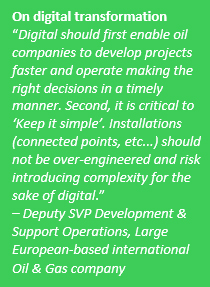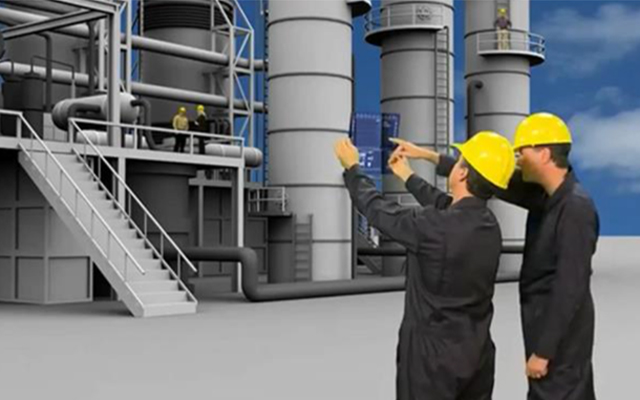Authors: Maurizio Rovaglio, Vice President, Oil & Gas Technology and Alliances, Schneider Electric, and Jack Creamer, Market Segment Manager, Pumping Equipment–Industry Business, Schneider Electric
In the past, Oil & Gas industry supply chain operations used a host of different tools and software applications to address a particular aspect of the operation. This resulted in hundreds of people working in isolated silos — with limited visibility into or knowledge of the implications their individual decisions had on the overall supply chain performance.
This lack of alignment cost Oil & Gas organizations tens of millions of dollars annually. By using a cloud-based approach to implement a unified supply chain management solution to the Oil & Gas market, collaboration can be enabled across the entire supply chain to help traders, planners, and schedulers make reliable decisions, manage risks, and increase profitability.
The huge momentum towards the implementation of computing systems in the cloud, is also impacting automation and control. The marriage of control systems and the cloud is central to helping industrial stakeholders leverage the potential benefit of IIoT business performance gains.
 The basic requirements of control systems include maximum uptime, reliability, quality and speed in order to make optimal use of the enterprise’s production resources. At the same time, operating security and the confidentiality of sensitive information within these systems needs to be preserved. The core pillars of dependability and cybersecurity are critical needs for O&G companies and a key focus the OEM suppliers they engage.
The basic requirements of control systems include maximum uptime, reliability, quality and speed in order to make optimal use of the enterprise’s production resources. At the same time, operating security and the confidentiality of sensitive information within these systems needs to be preserved. The core pillars of dependability and cybersecurity are critical needs for O&G companies and a key focus the OEM suppliers they engage.
No enterprise is going to want to rely on a server or personal computer if the operating system and the software are less stable and their uptime inferior to a dedicated control system. Stopping a production facility will result in huge financial costs.
Cloud computing providers are assessed by the uptime of their systems. They invest extensively in the security of the computing infrastructure; they have far greater incentive to invest in uptime and security than any individual enterprise that is more focused on their core business (like production and delivery of Oil & Gas). As a result, computing systems of cloud service providers are among some of the most stable and secure computing options. Stability is crucial, as the cost of downtime is estimated to be is substantial, from $1 million a year for a typical mid-size company to over $60 million for a large enterprise (footnote #1).
Numerous process performance Software as a Service (SaaS) models are springing up across industries offering users a flexible and economic means for streamlining key business processes. In the Oil & Gas industry these “as a service” flavors include the following:
- Supply chain (from trading to refined fuel selling)
- Process design and simulation
- Asset monitoring and management
- Advanced process control
- Process automation
- Remote monitoring
As an example, the benefit generated by process performance SaaS through online real time asset monitoring and optimization could be very high. In a refinery, for example, a CDU (primary distillation unit) of 250,000 barrels a day can generate, through online optimization, an additional value of more than $5 Million a year.
However, if managed internally, the maintenance of updated, tuned and effective online applications presents some significant challenges in terms of infrastructure costs and skilled resource availability. In many cases, early attempts at deployment have resulted in the application being turned off due to poor performance resulting from process to infrastructure mismatches or hardware obsolescence.
A Cloud process performance “as a service” solution running in a dedicated secure data center can directly address these challenges in the following ways:
- Updated “best in class” infrastructure is always available as service providers are constantly updating their hardware and software
- The cloud business model is kept up to date as this represents the provider’s core business
- Scalable, easy to install infrastructures are available that are paid for only on an “as needed” basis (elimination of significant up-front costs)
As a long term vision, only the sensors and the final control devices will be installed at a production site, each equipped with its own individual IP address and some edge computing capabilities in specific cases. The full control system will be driven more and more by a Software Defined Architecture (SDA) based on a platform running in the cloud (public or private). The architecture will enable operators to identify every device, will allow for the remote execution of the corresponding operating logic and will exchange only the required data. This approach has already been applied to productivity tools such as Historians, Human Machine Interfaces (HMIs) and Programmable Logic Controllers (PLCs).
Footnotes:
- IHS Markit, “Businesses Losing $700 Billion a Year to IT Downtime, Says HIS”, January, 2016
This article is part of an eight-part series looking at how the Industrial Internet of Things (IIoT) concepts are transforming the Oil & Gas industry business model. For more information, please visit: goo.gl/4ohXN7.
READ PART 1 | READ PART 2 | READ PART 3 | READ PART 4 | READ PART 5 | READ PART 7
About the Authors
Maurizio Rovaglio is Vice President of Oil & Gas Technology and Alliances at Schneider Electric in Italy. Mr. Rovagilo holds multiple patents and has authored over 100 technical articles published in international scientific journals, and has delivered presentations at multiple international conferences. Mr. Rovaglio has over 15 years’ experience in software sales, marketing, resource planning and project execution in the O&G domain across the world.
Jack Creamer is Schneider Electric Segment Marketing Manager – Pumping Equipment, based in the United States. Mr. Creamer has more that 30 years in the Electrical Industry, and has been involved for 10 years in the Pumping Industry. He is involved in key industry organizations such as the Hydraulic Institute and Submersible Wastewater Pump Association, where he holds both Committee Chair and Board level positions. In his time in the Pump industry, he has help Schneider create numerous solutions that both enhance pumping efficiency and address issues such as maintenance and downtime.




